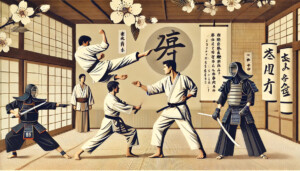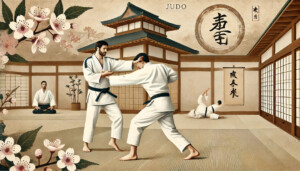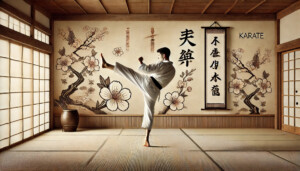1. International Interest
Japanese martial arts, including judo, karate, and kendo, attract significant international interest. These martial arts are well-known and loved not only in Japan but around the world. Particularly, judo and karate are recognized as Olympic sports and are showcased in international sports events, further sparking interest among foreigners in Japanese martial arts.
International competitions and events highlight the high skill and spiritual aspects of Japanese martial arts, leading many foreign practitioners to train in Japan. They study at traditional Japanese dojos, then bring back the skills and philosophies they learned to their home countries, thus spreading the popularity of Japanese martial arts globally.
The proliferation of the internet and social media has also allowed information about Japanese martial arts to reach audiences worldwide instantly. Platforms like YouTube and Instagram host numerous videos where Japanese martial artists demonstrate techniques and training methods, attracting many followers. This widespread sharing of information enhances interest in martial arts.
Additionally, the Japanese government and various organizations promote international exchange, with numerous cultural exchange programs centered around martial arts. These programs enable people from around the world to experience and understand Japanese martial arts deeply. Examples include martial arts classes in overseas universities and schools, as well as sending Japanese instructors abroad.
In summary, Japanese martial arts attract people not only for their technical prowess but also for their spiritual and cultural backgrounds. The international interest in Japanese martial arts is expected to continue growing. A website dedicated to these martial arts would serve as a valuable information source for enthusiasts and newcomers worldwide.

2. Cultural Appeal
Japanese martial arts are not just sports or combat techniques; they have a profound cultural background and philosophy. This depth is a significant factor that attracts many people. Through martial arts, one can learn about Japanese history, philosophy, and spirituality.
The origins of martial arts trace back to ancient combat techniques, but their purposes and values have evolved over time. For example, kendo is deeply rooted in samurai culture, emphasizing not only sword techniques but also the spirit of bushido. In kendo matches and training, etiquette and respect for opponents are crucial, which are lessons applicable to modern human relationships and self-discipline.
Judo, known as “the gentle way,” is based on the philosophy of using an opponent’s strength to win. This concept promotes a flexible approach to situations and resilience in adversity. Through judo training, mental strength and patience are developed, making it valuable for both the sport and personal growth.
Karate, originating in Okinawa, also boasts a long history. While its techniques focus on self-defense, it has a deep-rooted philosophy. Karate dojos emphasize both the acquisition of skills and the cultivation of the mind. Training fosters harmony between body and mind, which is a significant draw for practitioners.
Furthermore, the traditional attire and equipment used in martial arts, such as kendo armor and bamboo swords, judo uniforms, and karate belts, symbolize each martial art’s history and culture. These items are more than just tools; they represent the rich heritage of martial arts.
Overall, Japanese martial arts captivate people with their technical prowess and cultural and philosophical teachings. A website that delves into these cultural aspects would be a valuable resource, helping people deepen their understanding and interest in martial arts.

3. Educational Value
Japanese martial arts offer profound educational value, extending beyond mere combat skills or sports. Judo, karate, kendo, and other martial arts emphasize the importance of spiritual training, etiquette, and self-discipline. These elements are highly beneficial in modern education and personal development.
Firstly, martial arts place great importance on etiquette. The practice of bowing when entering a dojo or before starting training fosters respect for others. Such manners are valuable skills in daily life and business settings. Additionally, showing respect to instructors and senior practitioners teaches the importance of hierarchy and teamwork.
Through martial arts training, practitioners develop self-discipline and patience. Mastering techniques requires repeated practice, which demands perseverance and concentration. Experiencing loss or failure in matches or training fosters self-reflection and the importance of improvement. These experiences build resilience and promote self-growth.
Martial arts also emphasize the balance between mind and body. Besides physical training, maintaining mental calm and stability is essential. For example, in kendo, staying composed during matches is crucial, enhancing mental strength. Similarly, judo and karate stress harmony between the body and mind. Such holistic training is highly beneficial in the stress-laden modern world.
Additionally, martial arts’ educational value is incorporated into school education. Many Japanese schools include judo or kendo in physical education classes or extracurricular activities. This teaches students the importance of etiquette and self-discipline. Competitions and matches foster a sense of competition and teamwork.
Overall, Japanese martial arts offer significant educational value. The lessons in etiquette, self-discipline, and mental strength are highly beneficial in modern society, contributing to personal development and education. A website highlighting these educational aspects would be a valuable resource for many.
4. Community Formation
A website dedicated to Japanese martial arts can serve as a valuable platform for forming a community of martial arts enthusiasts. It can function as a place where people interested in martial arts can gather, exchange information, and interact, contributing to the dissemination and development of martial arts.
Firstly, the website can function as a hub for sharing and exchanging information. Providing the latest news, event information, competition results, and training methods allows users to stay updated. Additionally, articles and columns by experts and experienced martial artists can cater to a wide range of skill levels, from beginners to advanced practitioners.
Next, forums and chat features allow users to directly interact with each other. Posting questions or doubts about martial arts and receiving advice and information from other users creates a supportive environment. This active exchange of information benefits beginners and facilitates information sharing among experienced practitioners, strengthening the community’s sense of unity and contributing to the spread and development of martial arts.
Introducing local dojos and clubs helps users find suitable training locations. Posting reviews and ratings of dojos and clubs provides reliable information. Additionally, dojos and clubs can use the platform to promote themselves, attracting new members and revitalizing local martial arts communities.
The website can also promote events and recruit participants. Posting information about seminars, workshops, and competitions and recruiting participants makes martial arts events more exciting. Online events and live streaming enable distant users to participate, connecting martial arts enthusiasts nationwide and worldwide beyond physical distances.
In summary, a website dedicated to Japanese martial arts can greatly aid in sharing information and forming communities. Providing a place for martial arts enthusiasts to gather, interact, and learn from each other contributes to the spread and development of martial arts. It would be a valuable resource and interaction platform for everyone interested in martial arts.

5. Demand for Online Learning
The demand for online learning and training has rapidly increased in recent years. Particularly after the pandemic, many people needed to learn or train at home, elevating the importance of online platforms. Japanese martial arts are no exception, and the demand for online learning in this field is expected to grow.
The biggest advantage of online learning is the flexibility in time and location. For busy modern people, it is convenient to train and learn at home at their own pace, even if they cannot regularly visit a dojo. This allows people who cannot attend a dojo due to work or family commitments to continue learning martial arts.
Online learning caters to a wide range of levels, from beginners to advanced practitioners. Beginners can learn basic techniques and etiquette, while advanced learners can receive instruction on advanced techniques and strategies. This allows users to choose content that matches their level and efficiently improve their skills.
Furthermore, online learning offers visual learning through videos and live streaming. Watching demonstrations by professional martial artists and instructors while practicing at home makes skill acquisition smoother. Additionally, the ability to rewatch recorded videos helps learners study detailed movements and techniques thoroughly.
Interactive elements are also a draw of online learning. Using forums or chat features on the website allows users to ask questions or seek advice, resolving doubts and interacting with other learners and instructors. Online seminars and workshops provide real-time instruction and feedback, offering an experience similar to traditional face-to-face instruction.
Online learning also contributes to forming an international martial arts community. Martial arts enthusiasts worldwide can connect online, exchange information, and share techniques, enabling learning from a global perspective. Interacting with people from different cultures and backgrounds brings new insights and discoveries, enhancing understanding and skill improvement in martial arts.
Overall, the demand for online learning is expected to continue growing, and an online platform dedicated to Japanese martial arts is highly beneficial. Leveraging the flexibility of learning anytime and anywhere and catering to a wide range of learners helps convey the charm and value of martial arts to many people.
6. Tourism and Experiential Programs
For tourists visiting Japan, experiencing martial arts is a highly attractive program. As part of immersing in Japanese traditional culture, actually experiencing martial arts like judo, karate, and kendo is a highlight of tourism. A website providing detailed information on these experiential programs would be a valuable resource for tourists.
First, martial arts experiential programs offer an excellent opportunity to deeply understand Japanese history and culture. Through training at a dojo, tourists can learn basic techniques and etiquette of martial arts. For instance, at a judo dojo, they can experience basic falls and throws, and at a kendo dojo, they can wear armor and practice with bamboo swords. Such experiences allow them to feel the spirit and techniques of martial arts firsthand.
There are many specially arranged programs for tourists, such as short-term experiences, one-day experiences, and workshops lasting several hours. These diverse programs enable tourists to have a fulfilling martial arts experience even within limited timeframes. Moreover, many programs offer multilingual instruction, including English, ensuring that foreign tourists can participate comfortably.
Martial arts experiential programs shine even more when linked with tourist spots and accommodations. For example, programs at dojos near famous tourist spots in Kyoto or Tokyo, or tours where tourists stay at traditional inns while learning martial arts, create unique travel plans combining tourism and martial arts experiences.
Additionally, martial arts experiences provide tourists with special memories. Training at a dojo and interacting with instructors deepen their understanding of Japanese traditional culture, leaving them with memorable experiences. Often, the experience concludes with photos with instructors and certificates of completion, creating wonderful travel mementos.
A website introducing martial arts experiential programs for tourists should provide detailed information on access, reservations, and reviews. Highlighting program contents, introducing instructors, and sharing past participants’ experiences can attract tourists’ interest.
In summary, combining tourism with experiential martial arts programs is highly attractive to many tourists. Experiencing Japanese martial arts enhances the value of tourism. A website that introduces such programs and conveys the beauty of Japanese martial arts is expected to attract many people.
Comment